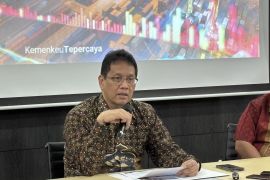"This time, herbal medicines are considered to be less effective, as they are not based on scientific evidence. Hence, later on, every plant having medicinal properties will be cultivated by standard," Head of the Bio Technology Program of the Agency for Assessment and Application of Technology Chaidir stated in Jakarta on Tuesday (Sept 4).
Herbal medicines, which are more affordable, can replace chemical drugs, especially for treating serious diseases. In addition, herbal medicines could be included in the Indonesian National Health Insurance System (BJS) formulary scheme.
In order to achieve this goal, Chaidir said the research approach should be carried out comprehensively. Medicinal plants, with healing properties, must be cultivated and be standardized, starting from nurseries to planting and post harvest. The extraction must be as prescribed to maintain the quality chain of medicinal raw materials.
Hence, the development and research of herbal medicines will use biosynthetic raw materials that can be mass produced to reduce the use of raw materials directly sourced from forests.
According to senior researcher at the United States Department of Health and Public Service`s National Medical Rehabilitation Research Center Hameed Khan, research and development as well as the cultivation of herbal medicines should not harm the forests.
Through the biosynthetic development process, the gene composition of medical plants is extracted. If an element in a plant or tree has the potential to be used as a herbal medicine, then the gene composition is taken.
"We will not take the entire plant or all the trees, but we will make it more with biosynthesis," Khan explained at the 2018 International Herbal Medicine Conference (IHMC).
He noted that raw materials derived from biosyntheses will use microbes to produce the desired drug element.
Chaidir revealed that for the time being, the anti-inflammatory properties of drugs to be developed were being prioritized that can be used for treating several types of diseases, such as cancer, diabetes, and asthma.
The country is believed to have 30 thousand herbal plants, of which only 13 thousand have been used to produce medicinal herbs. However, only a handful have been studied and proven to have healing properties.
Hence, the country should continue to conduct studies on its herbal plants to reveal their healing properties. Several Indonesians prefer to take herbal medicines, locally known as "jamu," to avoid the side-effects of modern drugs, to cure ailments, or just maintain general health and fitness.
Although most of the country`s medicinal herbs are yet to receive scientific recognition for their medicinal properties, jamu continues to attract consumers.
For instance, in 2010, based on data provided by the Health Ministry`s Research and Development Center, some 50 percent of the country`s population used jamu to treat ailments.
Hence, herbal medicines are quite popular in Indonesia. The country has some three thousand types of jamu products that have long been used in popular alternative treatments for tackling various health issues.
In order to support the development of the country`s medicinal herbs, Director General of Technology and Higher Education Resources at the Ministry of Research and Technology Ali Ghufron Mukti revealed that the government is developing joint research between higher education and the health sector.
"I am the chairperson of the Joint Committee of the Ministry of Research, Technology, and Higher Education and the Ministry of Health, under the steering committee of the Minister of Research and Technology and the Minister of Health. We hold a routine meeting every three months to discuss various types of problems faced by both sides, including herbal research," Mukti noted.
The director general praised the 2018 IHMC held at Yarsi University to scientifically document Indonesian herbal medicines that have been used by people since long. Hopefully, they would be used as prescribed drugs in the PBJS health insurance scheme.
"Indonesia is different from China, Hong Kong, and Taiwan where traditional medicines are included in the scheme. We have not done that as yet. We hope this forum would encourage the inclusion of herbal medicines in the national formulary. If it is included in the scheme, it will be very good," he remarked.
He added that one of the reasons for not including herbal medicines in the BPJS scheme is since there are differences in opinion among stakeholders regarding this type of medicine.
Essentially, scientific studies have, so far, claimed that certain types of medical herbs have proven the safety, properties, and quality of at least five jamu that can cure hemorrhoids, dyspepsia, osteoarthritis, light hypertension, hyperuricemia, and gout complaints.
Of the 30 thousand herbal plants, only 500 varieties have passed clinical tests on human beings and have been used to produce standardized herbal medicines (OHT) or phytopharmaca.
OHT has been categorized as medicines that cure a disease.
Till date, Indonesia has only eight types of phytopharmaca medicines, which have received licenses from the Food and Drug Supervision Agency to be put on sale.
Editing by Rahmad Nasution
Reporter: Andi Abdussalam
Editor: Fardah Assegaf
Copyright © ANTARA 2018












